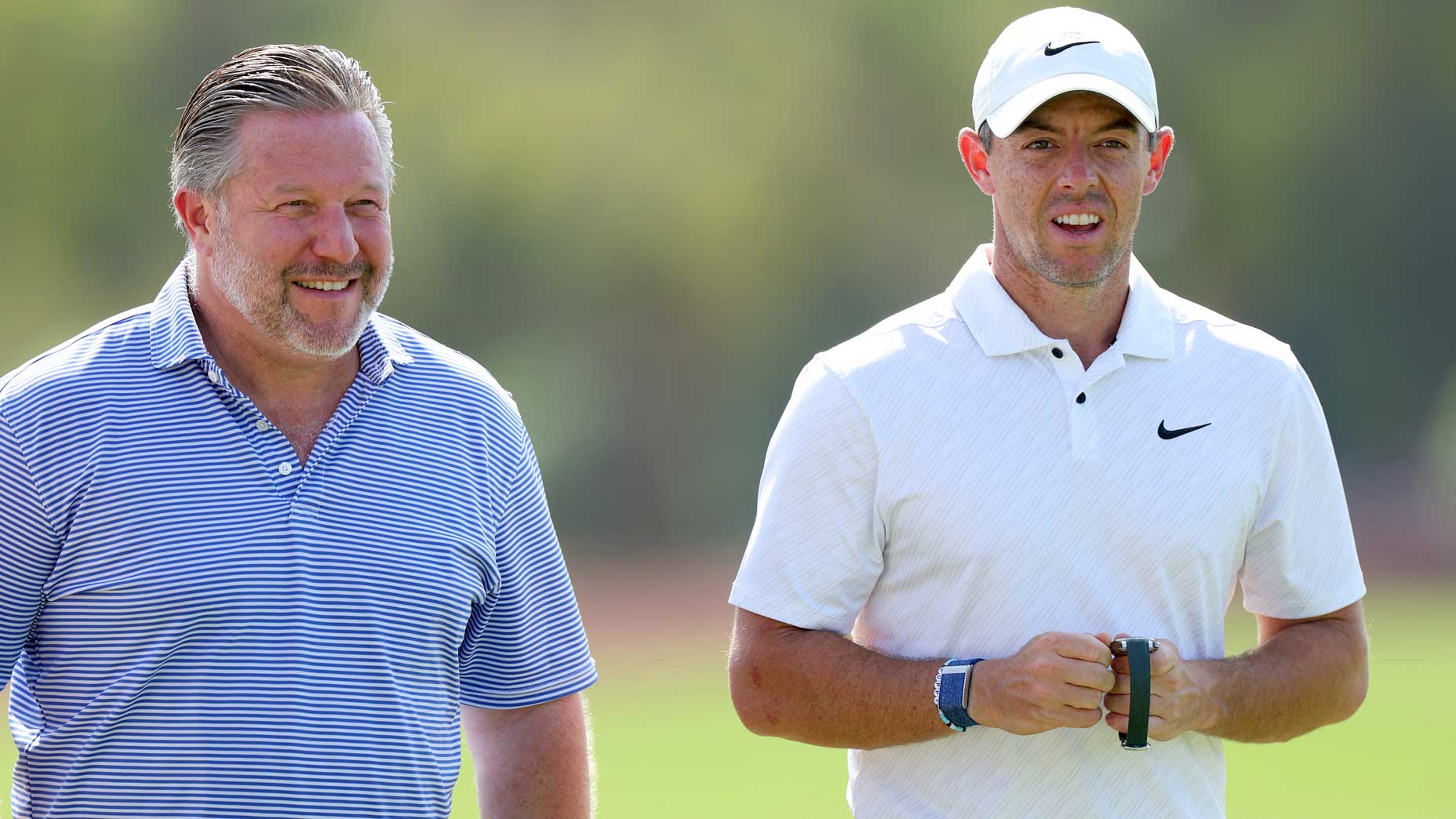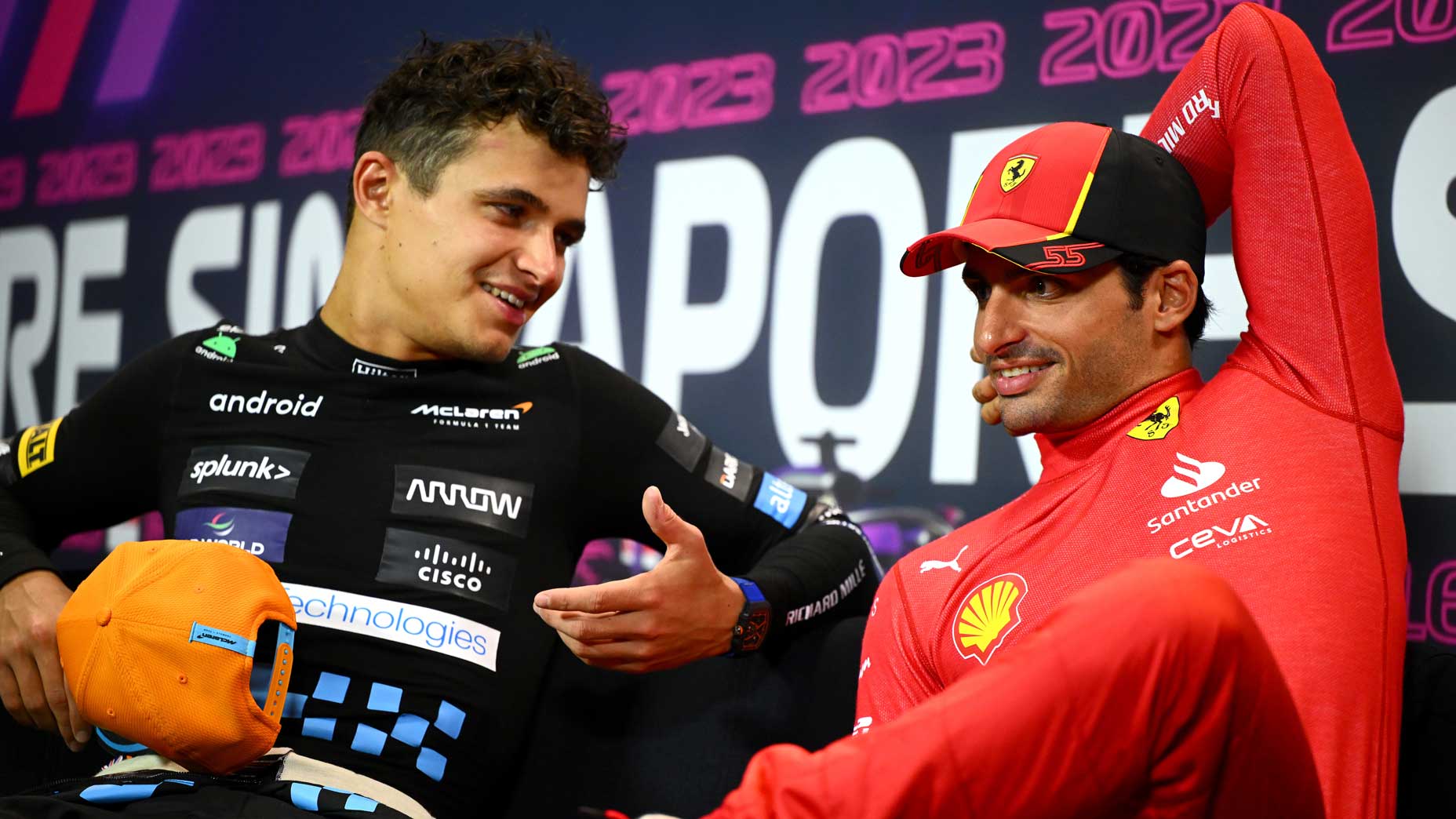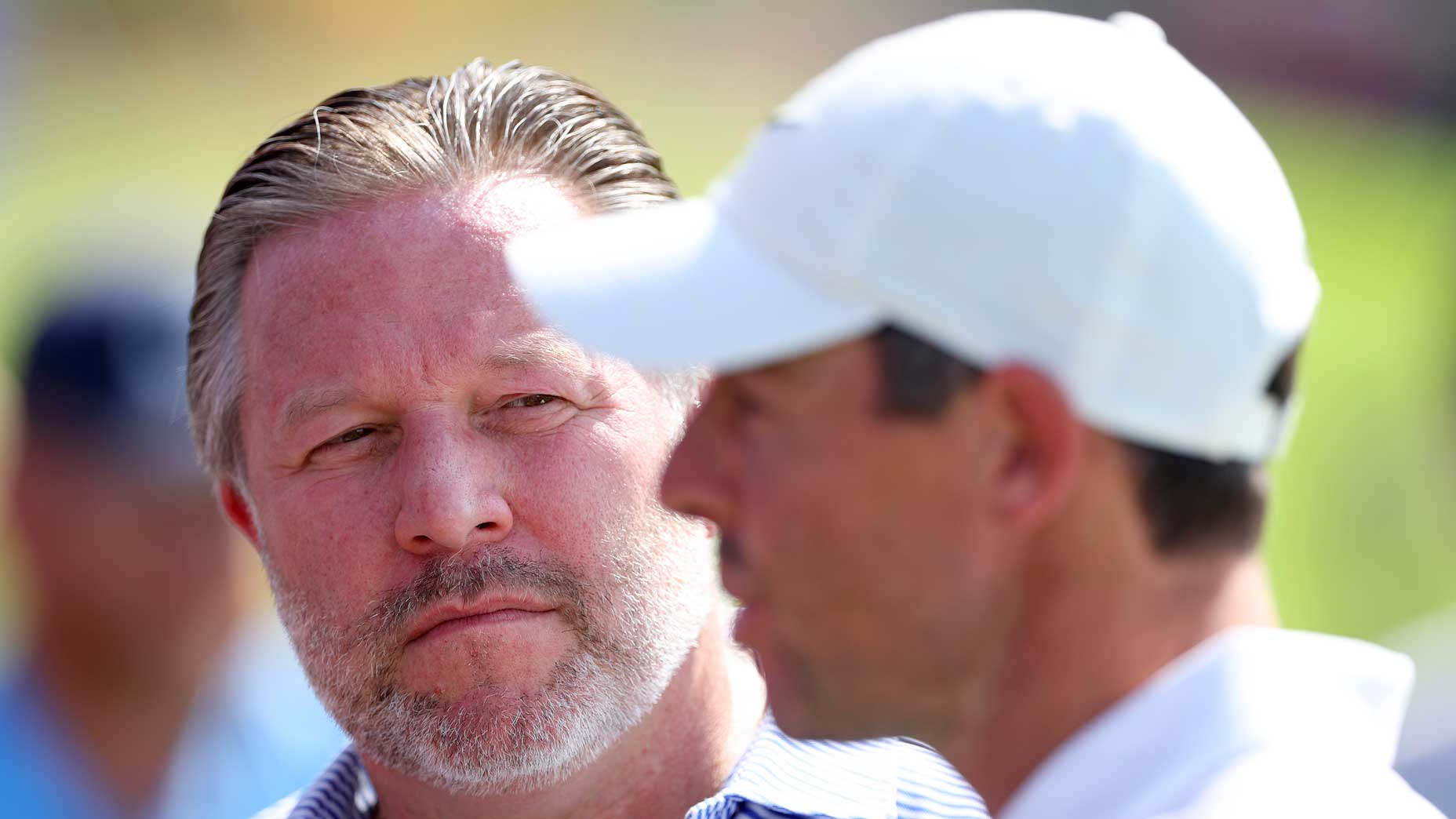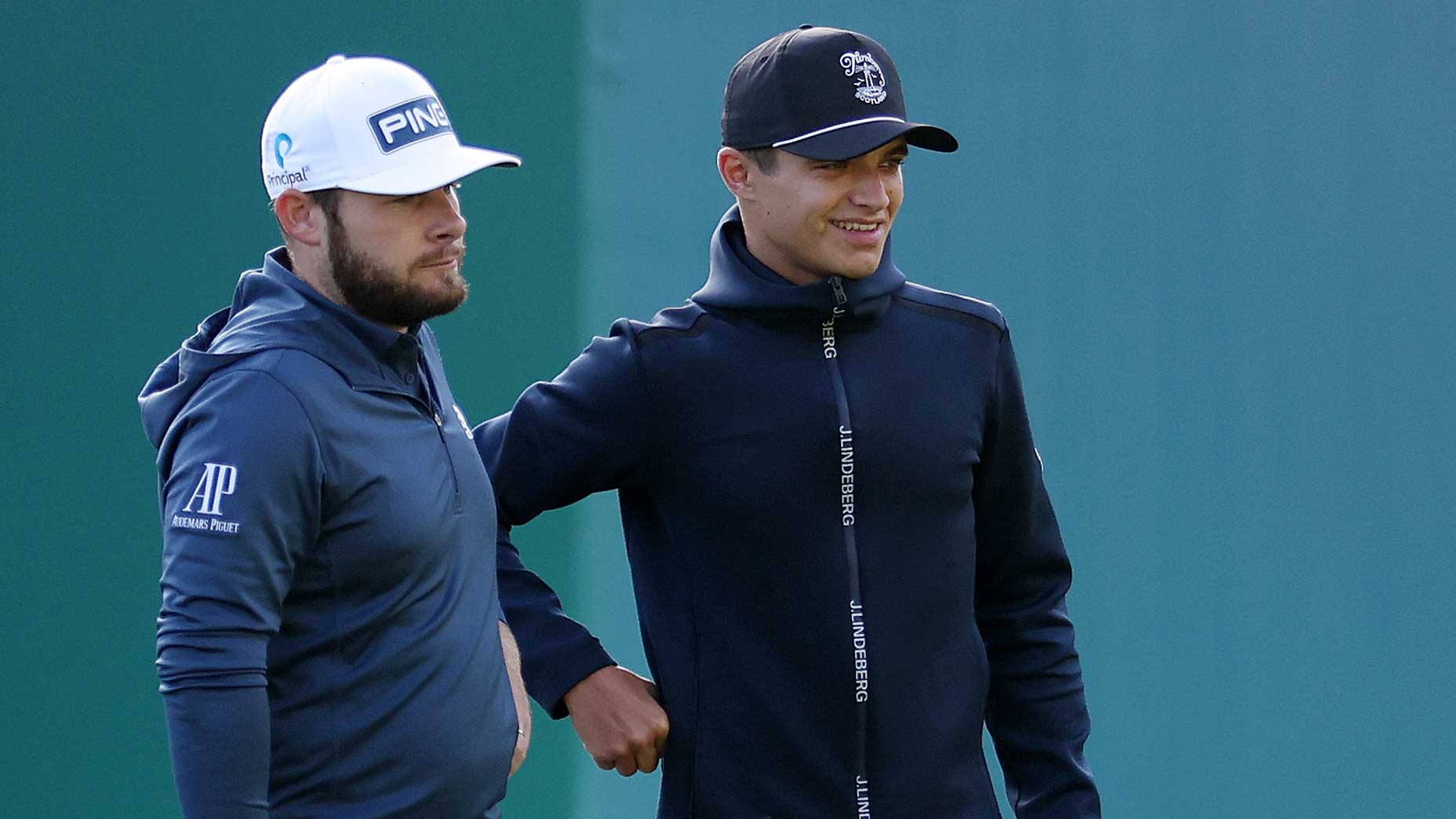Augusta invites, Netflix matches, big-money investments: Inside F1’s golf obsession

Lando Norris is the face of McLaren's F1 team — and the face of its golf addiction.
Getty Images
Next month he’ll tee it up in a groundbreaking Netflix golf match. This month he hiked the dusty hills of Marco Simone, cheering on Team Europe in person at the Ryder Cup. Last month he rubbed shoulders with Tyrrell Hatton at the BMW PGA Championship, picking up a few pointers along the way. But just four years ago Lando Norris was just another teenager who looked at golf and thought meh.
It’s safe to say that’s changed.
“It started with Topgolf,” says Norris, the 23-year-old star of McLaren’s Formula 1 team. The thought triggers a faraway look in his eye, like he’s accessing a fond memory of a first date. I’ve wrangled a precious half-hour with him and Zak Brown, McLaren’s CEO, both of ’em featured characters in Netflix’s Drive to Survive, and now here they are sitting side by side on a Zoom call from somewhere in the Bay Area, where they’re presumably on some sort of important business and coming off a big podium weekend that has Norris 7th in the driver standings and McLaren 5th in the Constructors Championship — but now they’ve carved out some time to chop it up about their favorite non-racing pursuit.

Back four years, then. Norris wasn’t into golf. Didn’t watch it. Didn’t play it. Didn’t understand why others would. The extent of his golf background was visiting Topgolf with a few of his good mates and seeing who could bash driver the furthest. Brown can relate to that; he didn’t start playing until he’d finished his own driving career, considering it an “old guys’ game” before he’d really tried it. But golf comes for us all.
And Norris’ conversion in particular speaks to several larger stories within the game — stories about golf’s growth these last few years, about new business opportunities, about the evolving nature of the pro game.
“It was Carlos,” Norris explains, referring to his teammate at the time, Carlos Sainz, Jr, likely the lowest handicap on the grid. “Carlos was playing golf and he said that I really needed to get out and play.”
The pair began their golfing journey with a trip to Topgolf, where Sainz offered some specific tips and tightened Norris’ focus from aimless bashing to specific targets. That engaged his competitiveness. From there, Norris was inspired to hit West Byfleet, a golf club just two miles from McLaren HQ, where he got a couple lessons before finally getting out on the course. It was the spring of 2020 and golf was on the brink of a participation boom, with covid upending how people spent their days and their free time, too. Norris would be a part of that boom.
“As soon as I played on the course I understood what it was really all about,” he says. “Ever since then I’ve watched every single weekend. Every game, ever since. I fell in love with it very quickly. I got addicted to it.”

THESE DAYS, F1 DRIVERS SEEM TO BE EVERYWHERE in golf. And golfers seem to be everywhere in F1. Rory McIlroy just joined an investment group going in on F1 team Alpine and has been spotted at F1 races for years. Norris is an investor in the stadium-golf startup TGL, the brainchild of McIloy and Tiger Woods. Sainz is investing in the TGL, too, as are fellow racers Lewis Hamilton and Alex Albon. When F1 made its debut in Miami last year, Norris teed it up that week with Dustin Johnson. Hamilton played with Tom Brady. When it came time for the race, there was Bubba Watson alongside Ian Poulter in McLaren’s hospitality unit. (Even if they seemed relatively anonymous compared to fellow attendees Michael Jordan and Michelle Obama.)
Heck, the very future of professional golf has an F1 tie-in: the first in-person meeting between Saudi PIF governor Yasir Al-Rumayyan and PGA Tour commissioner Jay Monahan came in Italy this summer, where Al-Rumayyan was attending the wedding of Aston Martin owner Lawrence Stroll’s daughter. That meeting was a reminder that while golf wrestles with the extent of its Saudi investment, F1 already has a race in Jeddah and its teams and grand prix are sponsored by Saudi government companies like Aramco. Perhaps F1’s construction hints to professional golf’s future.
The two sports are adjacent in another unlikely place, too: on Netflix. F1’s Drive to Survive kickstarted a modern wave of sporty docuseries and kickstarted F1’s U.S. popularity, too. Golf followed with its own season-long documentary, Full Swing (where, full transparency, I’m among the journalist-commentators) which boosted awareness and popularity across Netflix’s massive audience. Earlier this week it was announced that Netflix was breaking new ground by diving into the live sports space. How? With F1 drivers and professional golfers teaming up to tee it up in the first-ever Netflix Cup.
There are plenty of business synergies here. Brown is wise to those, and he’s grateful for the sponsors his team and golf’s major tours have in common. He ticks through ’em, and they’re familiar to anyone who’s been watching pro golf or eyeing Patrick Cantlay’s golf bag.
DP World. Hilton. DeWalt. Goldman Sachs. Workday.

Brown has blended business with pleasure by playing in pro-ams at some of golf’s biggest events. Those appearances have come through some sponsors and opened the door to more sponsors, too. That’s a big part of all of this — golf is good for business.
“Relationship-building. Meeting new people,” he says. “You get put in a foursome and you’re playing five hours with someone, you go from not knowing them to knowing them very well. So as a business tool, I think it’s awesome.”
BUT THERE ARE SIMILARITIES between the two sports that transcend convenience and business interests. While Brown insists that F1 is a team sport disguised as an individual sport, he acknowledges that despite a 200 mph speed disparity, a driver in a car and a golfer on a course have plenty in common.
“Once the lights go out it’s very much driver vs. driver,” he says. The similarities really begin, he says, when things might go wrong and when you might start to feel very alone.
“It’s the attention to detail and the focus. You have one bad corner you might be in the wall and your race is over. In golf you can walk shot to shot — but there’s no TV timeouts to recalibrate.”
Norris goes even deeper.
“I think a lot of it is just a mentality,” he says. “It’s a very similar mentality, even though you couldn’t think of them as being more different sports, in a way. But I think the mentality is very similar in terms of the competition, the desire to want to be perfect, never being satisfied with almost anything you ever do. And it’s such a repetitive sport, you know? For us, it’s every corner of your race. For them it’s every shot, every hole.
“I think you get through one and it’s like, how can I learn and do better on the next one, which for them it’s five minutes later, for me it’s five seconds later. This is the constant battle of playing against yourself or driving against yourself.”
Both are in awe of the games of top pros, not just from in-person viewing at the Ryder Cup but from actual friendly rounds with players like McIlroy, Jon Rahm, Ian Poulter, Justin Rose, Joaquin Niemann and others. Brown says those guys are on “another level to another level.”
“The thing that’s impressive is that yeah, every once in a while they hit a bad shot. But the thing that’s impressive is that they never hit two bad shots in a row. In the rare instance they get themselves in trouble, they immediately get out.”
And at McLaren, it’s not just Norris and Brown; their love for golf rolls deep. There’s a good group of golfers from across the company, he says. In southeast England, great golf is nearby, and the analytic minds of McLaren employees are a natural fit for recreational golf.
It was a revelation when Norris realized he could bring clubs with him on the road to play on Tuesdays and Wednesdays, off-days from the track. He can’t beat Sainz, he says, though he dreams of it. He’s about an 11 handicap at the moment, a few strokes better than Hamilton. Albon plays, too, as do Pierre Gasly, Charles LeClerc, Lance Stroll and others.

I ask Norris for the peak of his golfing life to this point. His answer comes with a pause and an admission of guilt.
“Probably playing Augusta,” he says. The guilt? “Look, I didn’t even like golf four years ago. Then it only took me a few years to play one of the coolest courses in the world and one of the hardest courses in the world to get to play?”
It’s a reminder how fast all of this has happened: fame, fortune, access to any golf club he wants. His is a good gig, if you can get it. From the members’ tees at Augusta, he says, he shot 88 or 89 — including an under-par trip ’round Amen Corner, highlighted by a birdie at the par-3 12th. Then they took a spin from the tournament tees. How’d that go?
“Definitely not that good,” he laughs. The second time through he hit it in the water at No. 12, he adds, just to feel what it’s like. “You realize how quickly it can all go wrong, like you’ve seen in the Masters so many times there.”
I’m curious to know their favorite parts about golf.
“Drinking,” Brown offers, but quickly gets earnest. “No, it’s the competitiveness. And the index system. You couldn’t handicap a professional driver in a race. But with the index system you could be competitive with anybody in any format. That’s fun.”
Both acknowledge that there’s something freeing about competition for competition’s sake; like other golf nuts from across the professional sports world, it’s nice to be all in on a sport where nothing is expected of you. Though that doesn’t stop Norris from expecting more from himself.
“My favorite part is just the days out with your mates,” he says. As long as he wins, that is. “Golf can ruin your day. It can ruin your week! It can have such a big impact in a good or bad way. You have one good or bad game and it can stay with you for a long time, especially if it’s with your friends.
“There’s something about golf, just going out and hitting the ball and not caring, in a way — but at the same time caring more than anything in the world.”

That’s largely what’s behind the Netflix Cup, and the trip to the Ryder Cup, and the further intertwining of two of the world’s highest-profile individual sports. Business drives passion, but passion drives business, too. And these guys know driving.
“I’d love to see McLaren get more involved,” Brown concludes. The brand did a limited-edition licensing arrangement with Swag Golf, making McLaren putters, headcovers and accessories in a test of the company’s crossover appeal. The speed with which they sold suggests a golf-racing audience that remains untapped. Untapped for now, at least.
“Obviously we’re in the racing business, I’m not working in golf,” Brown concludes. “But we love sport, so when there’s opportunity to get involved beyond what we’re doing, I would welcome it.”




